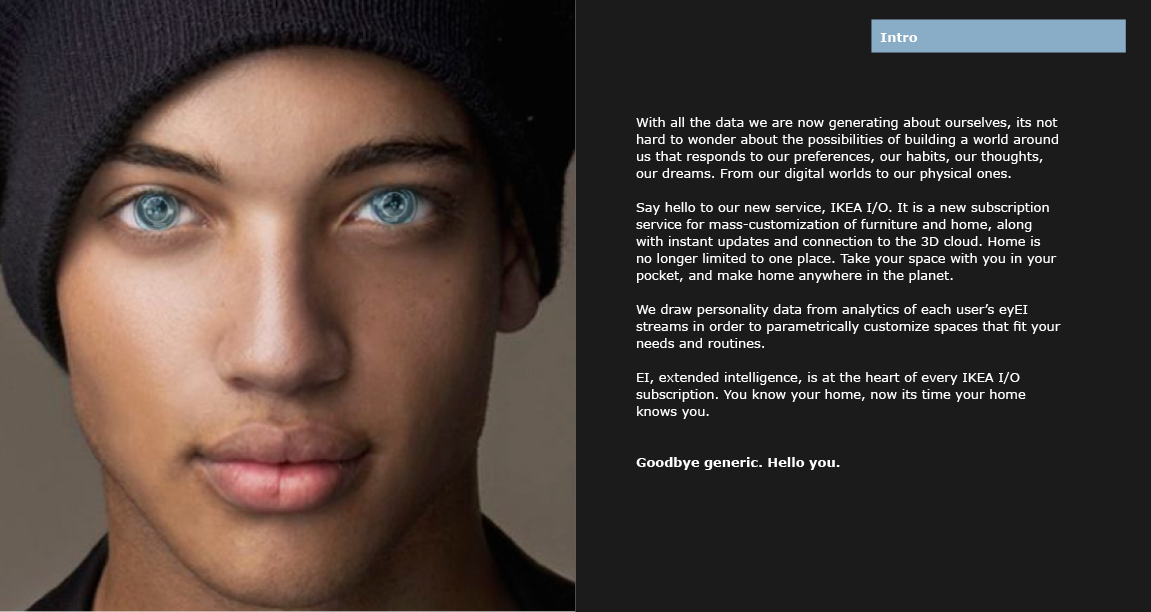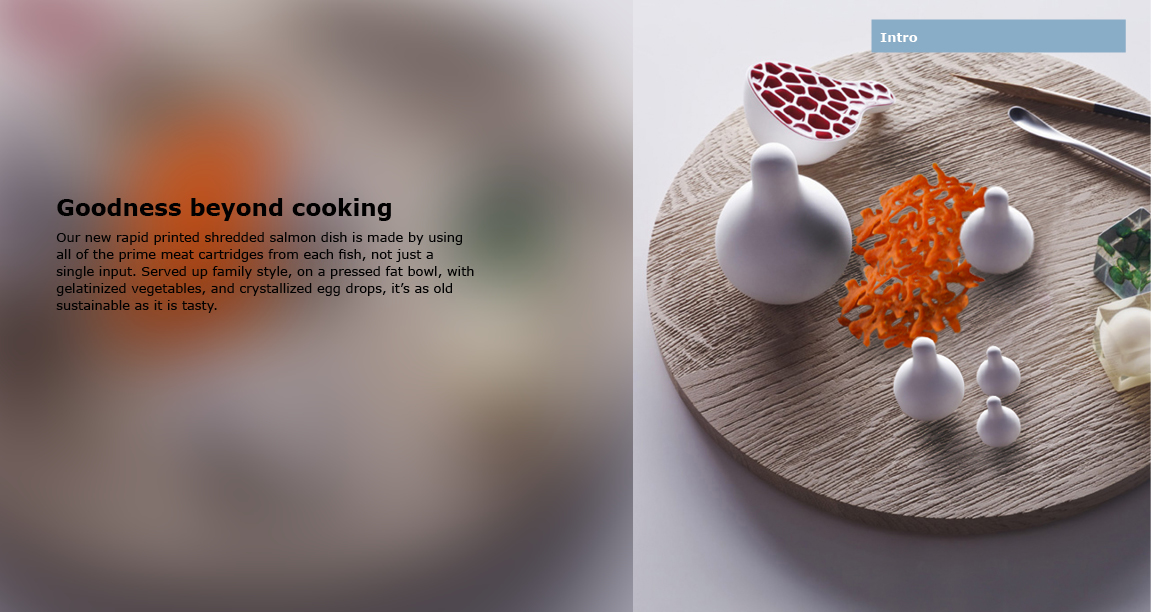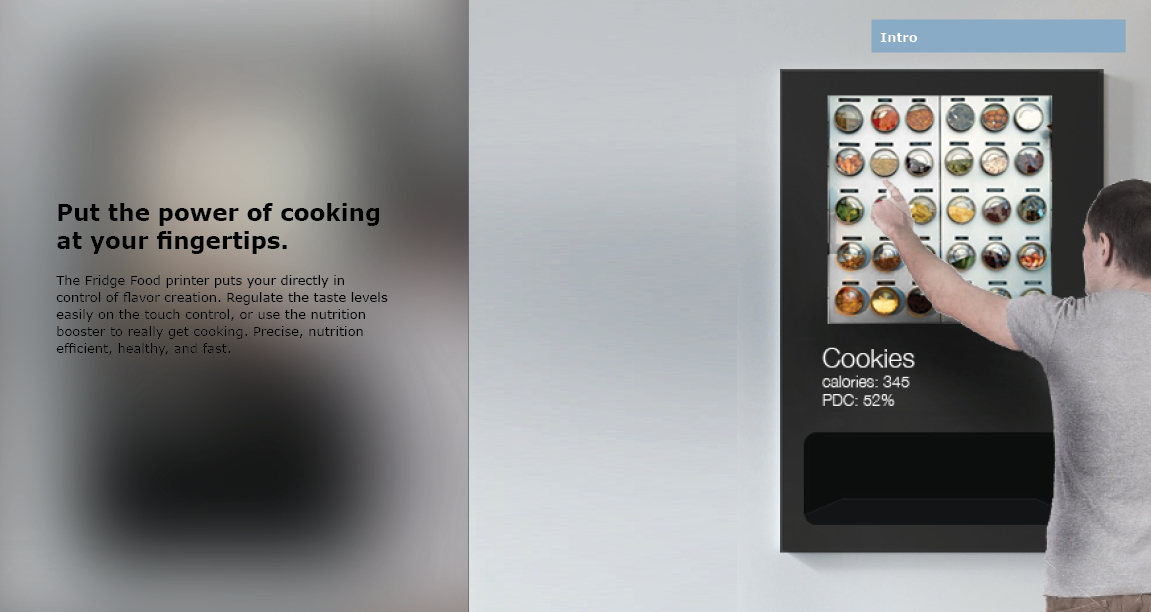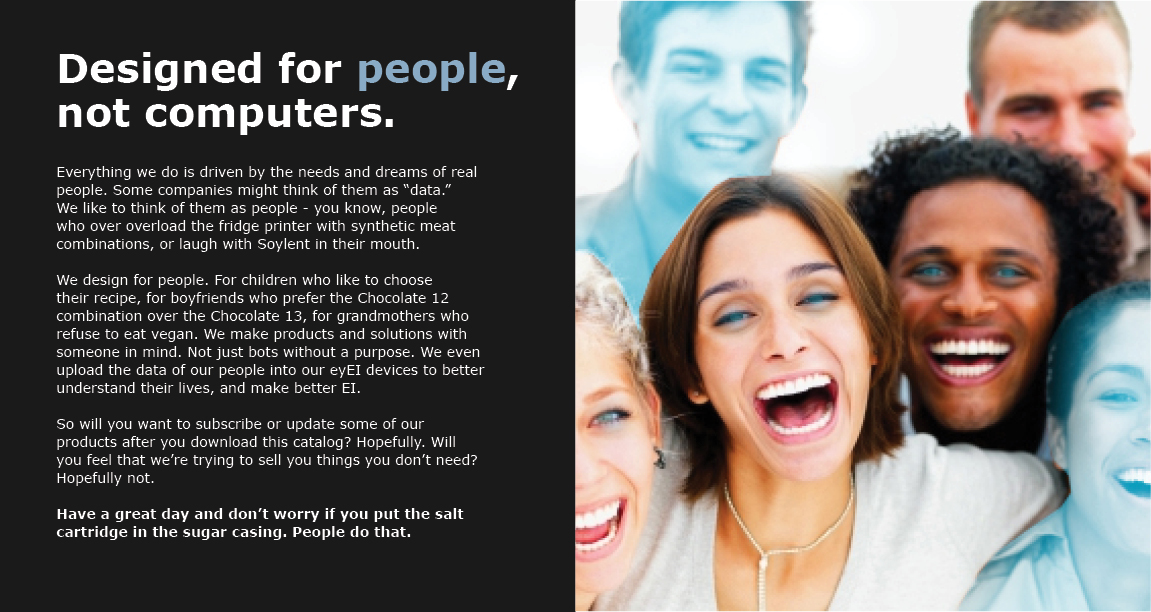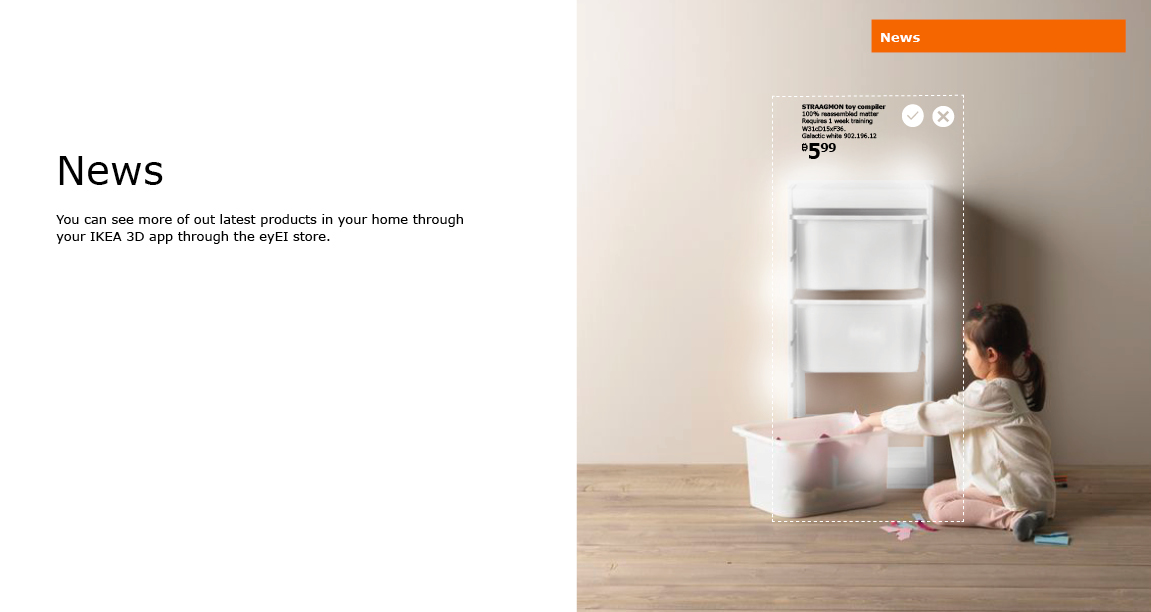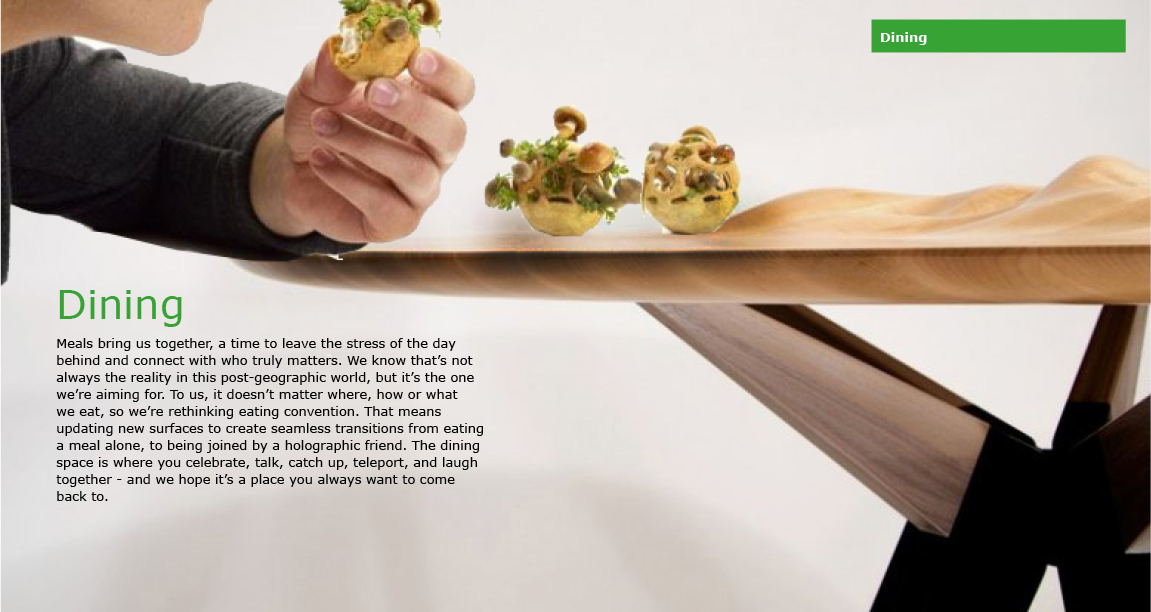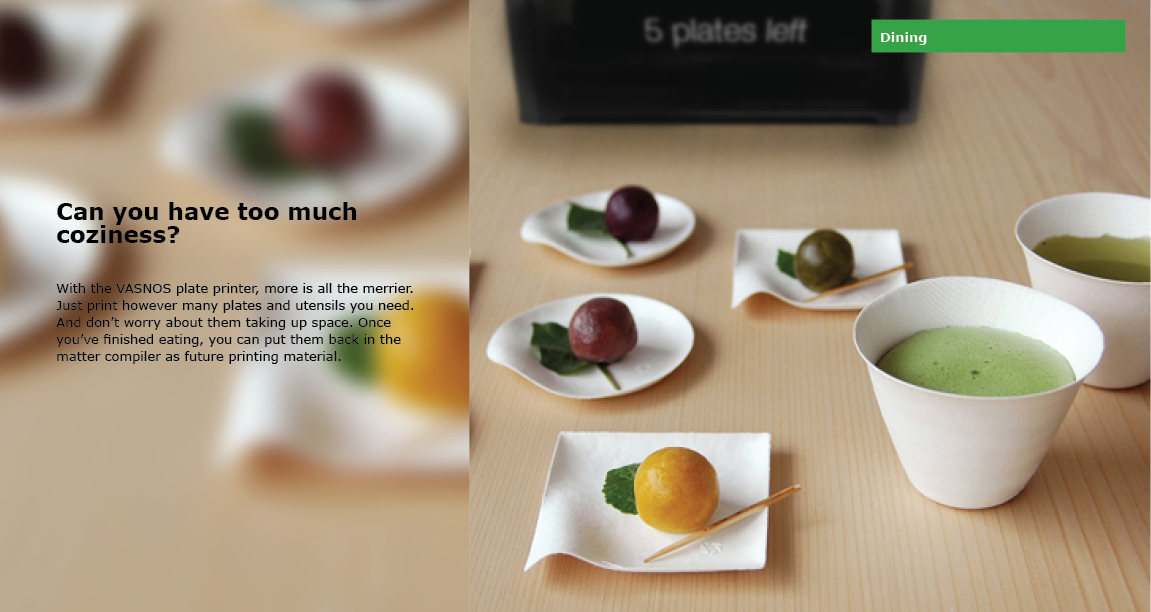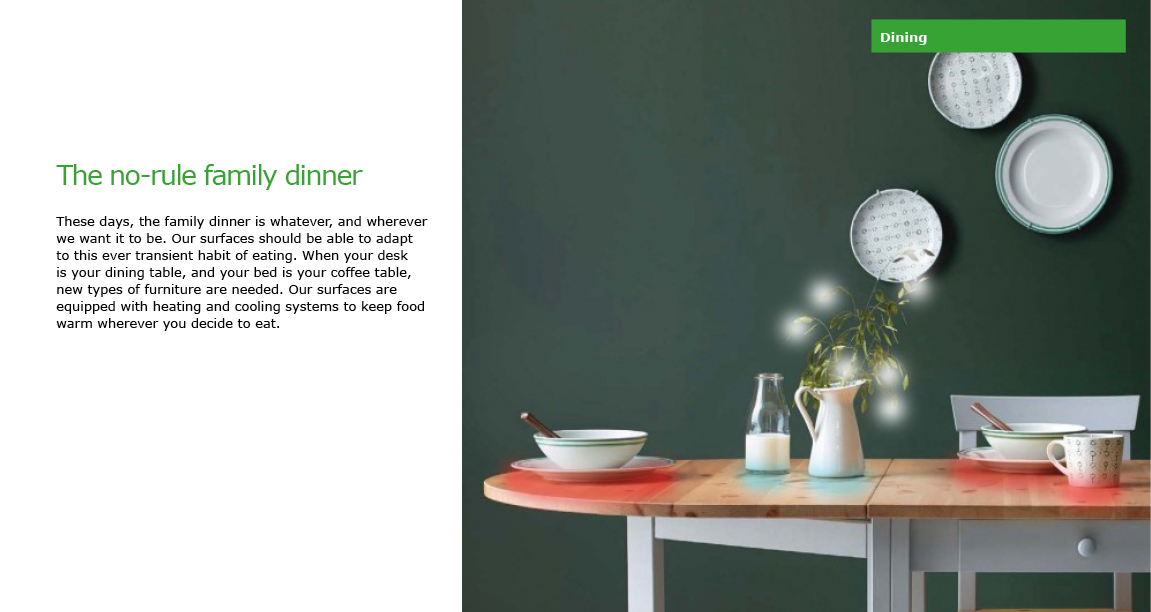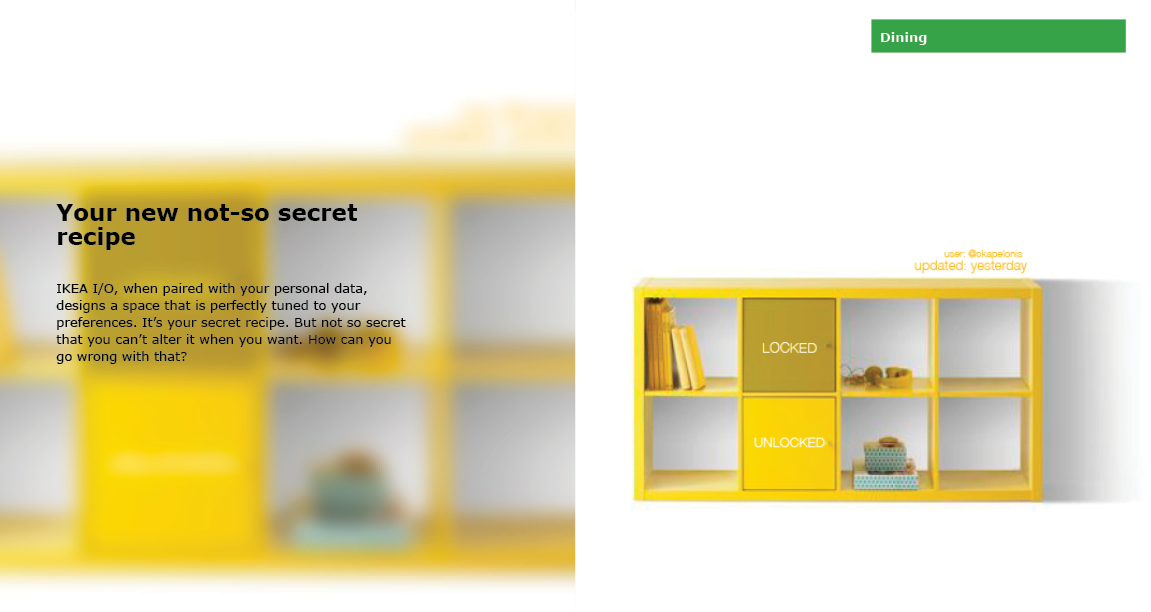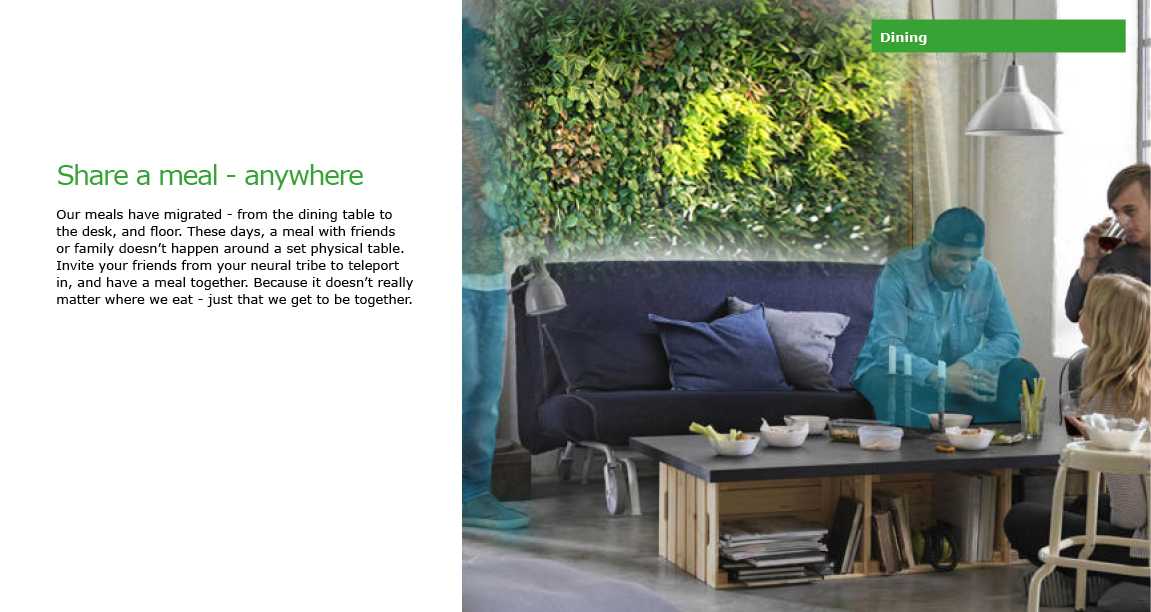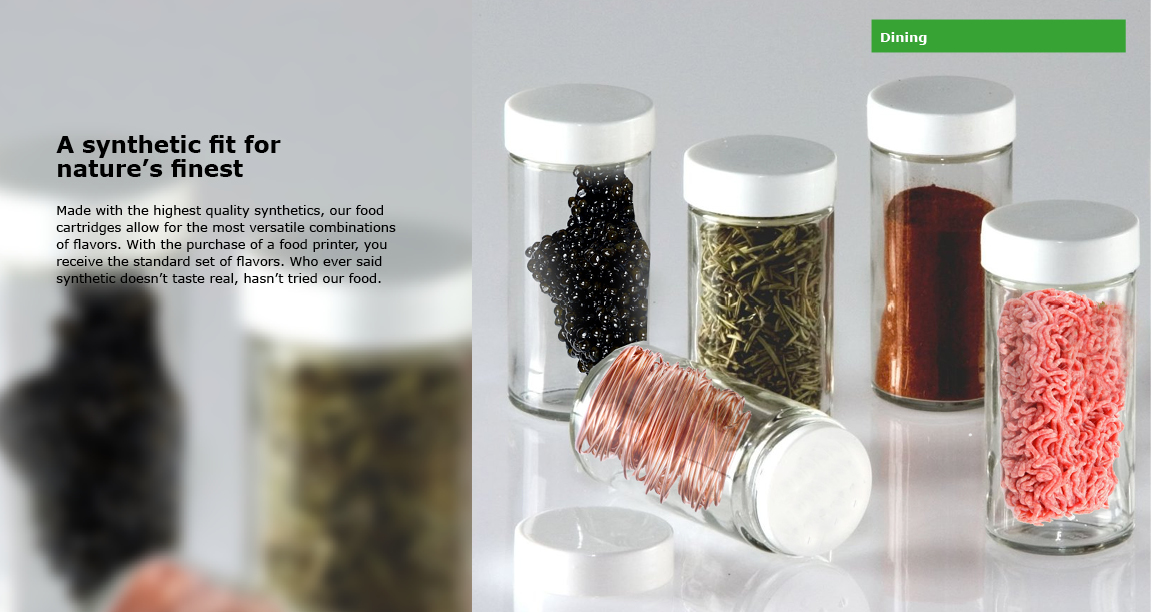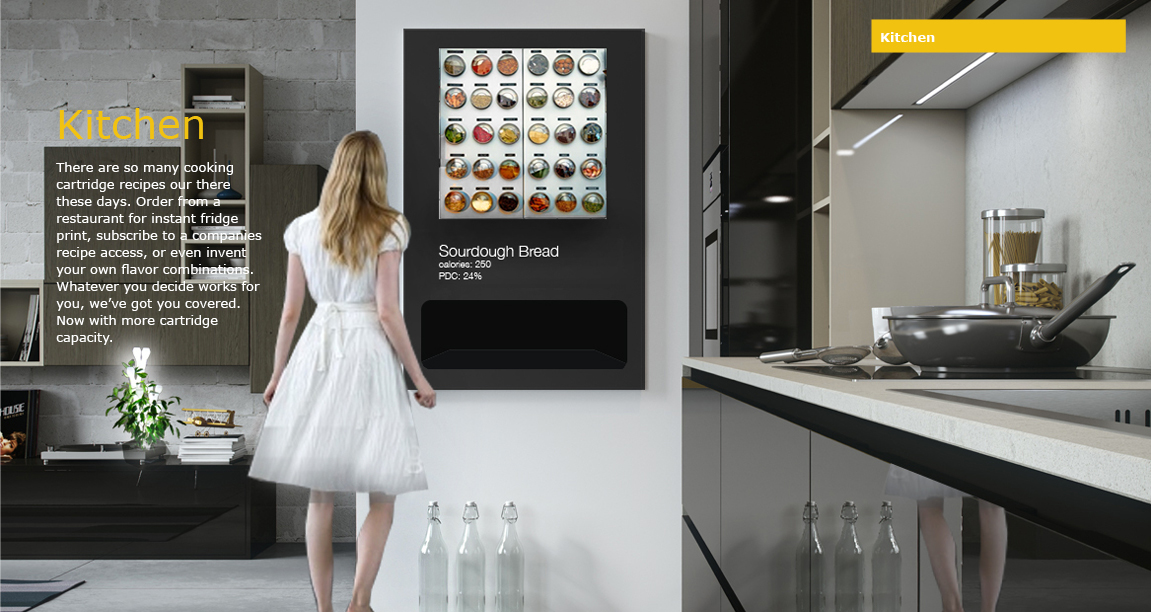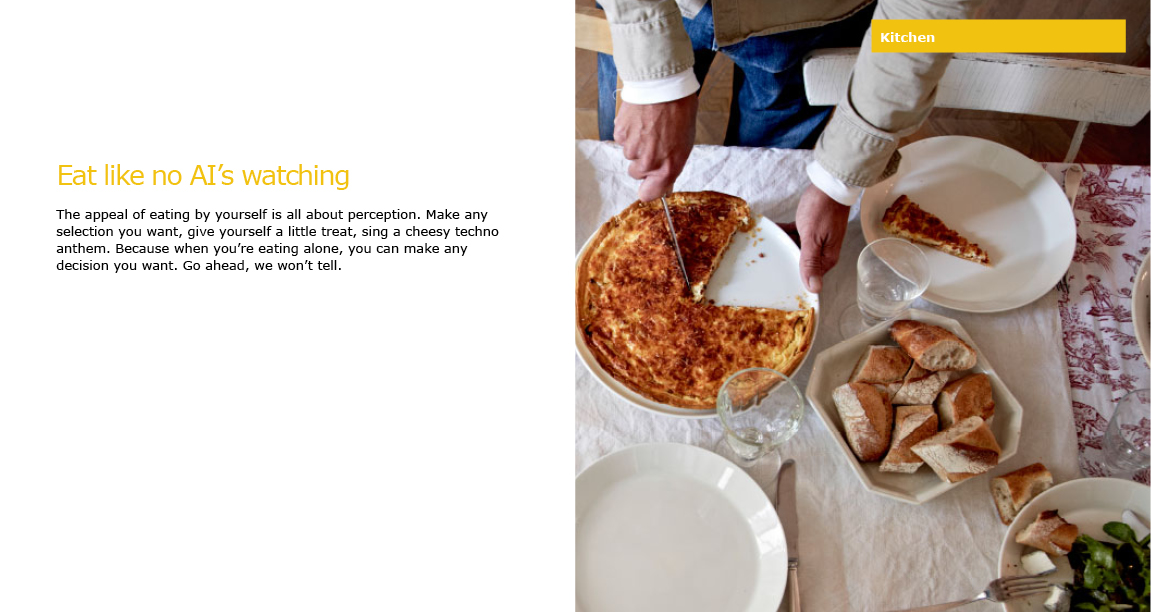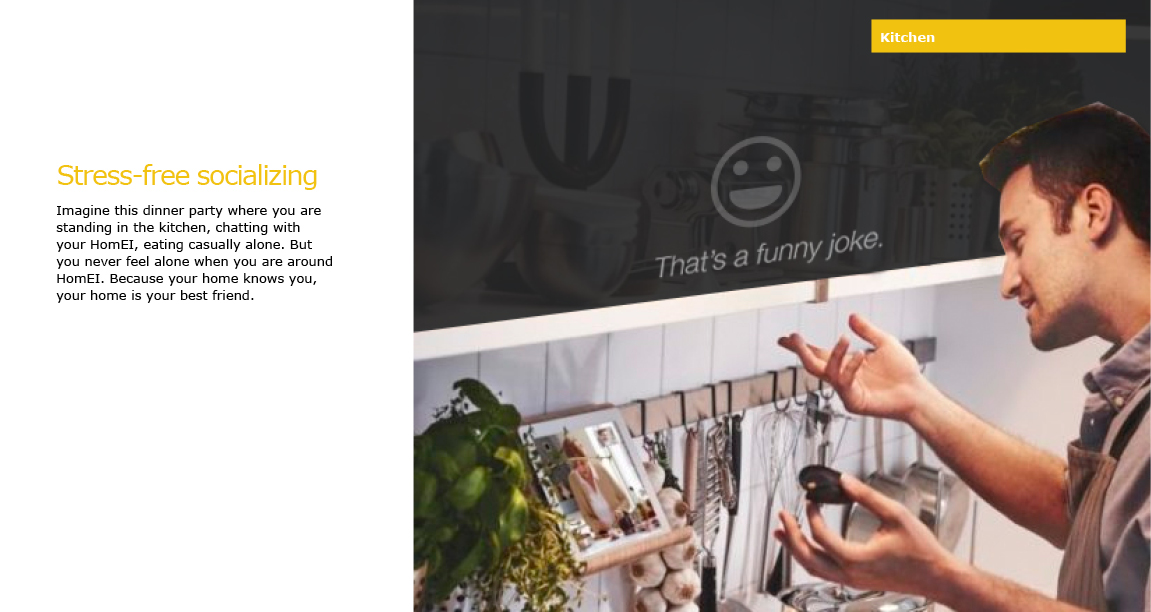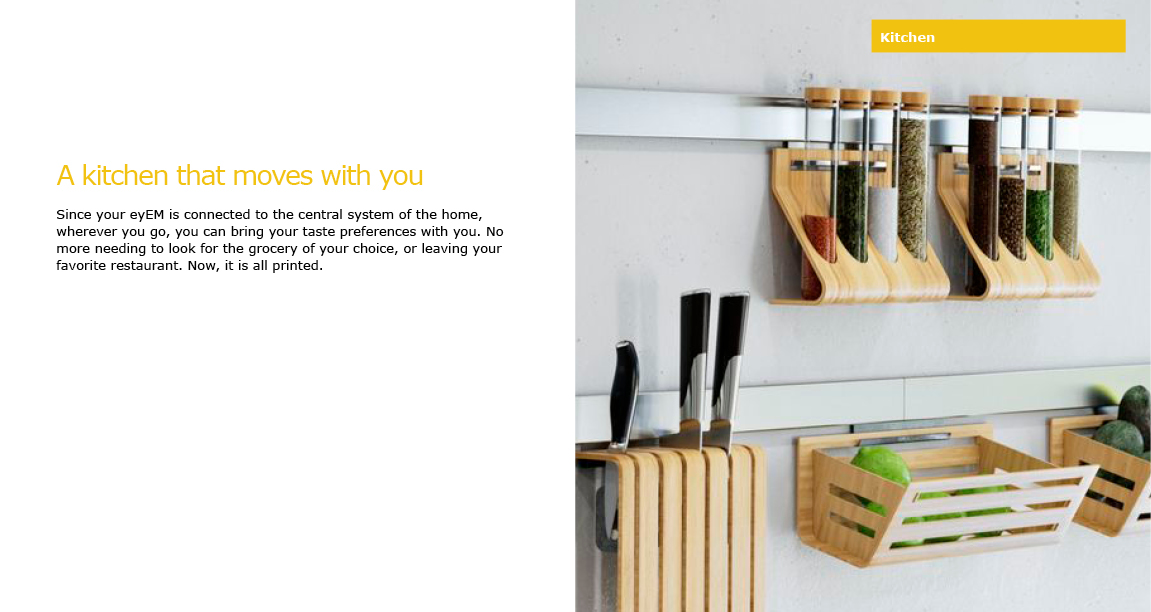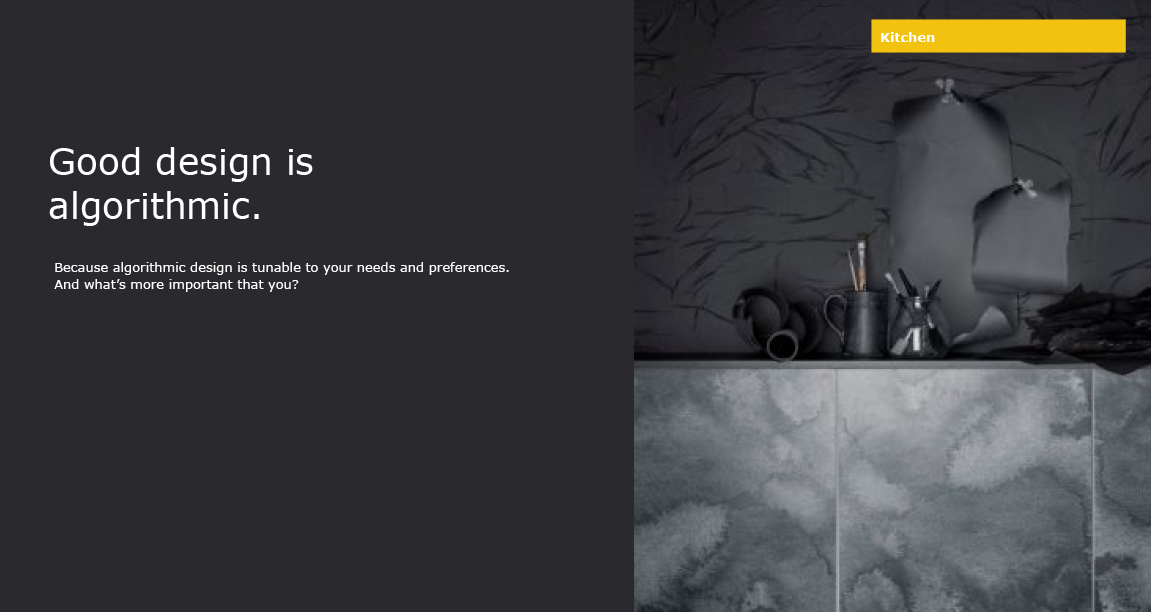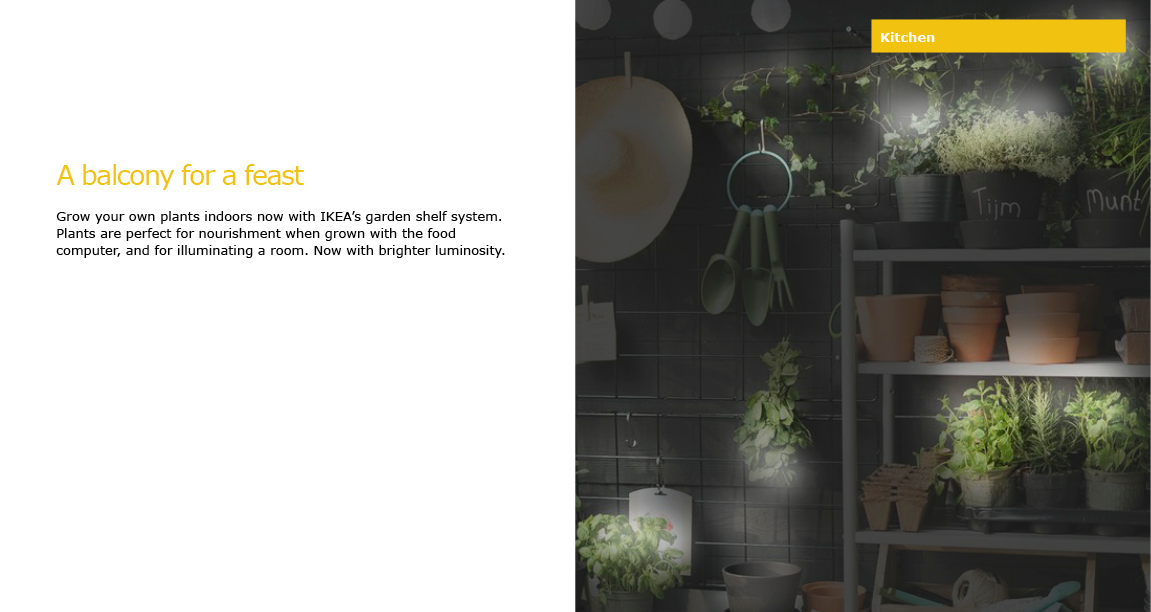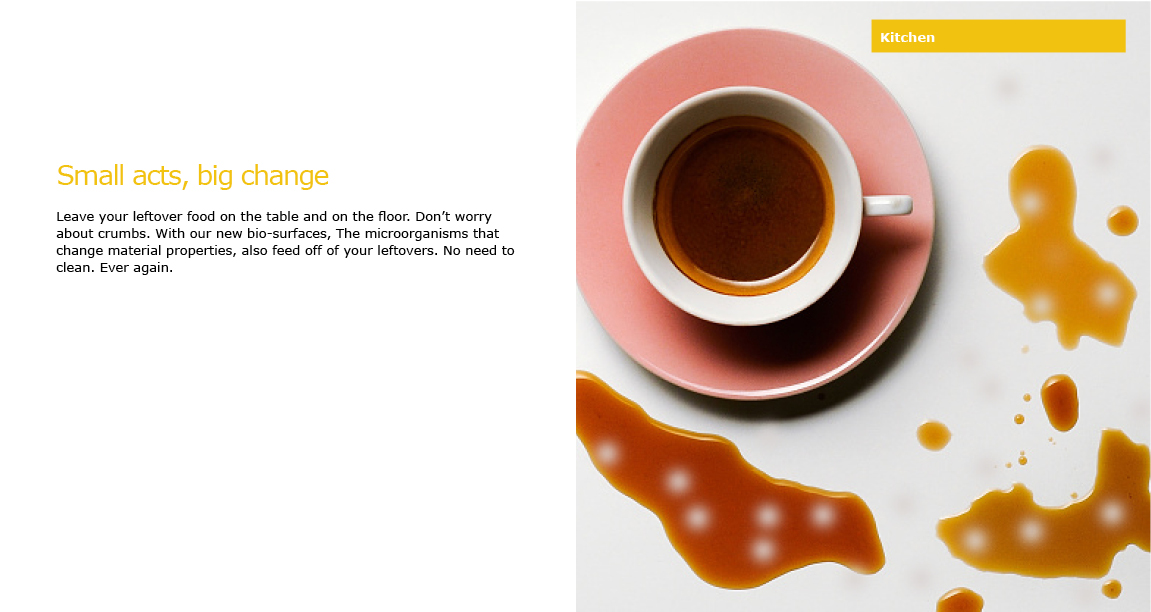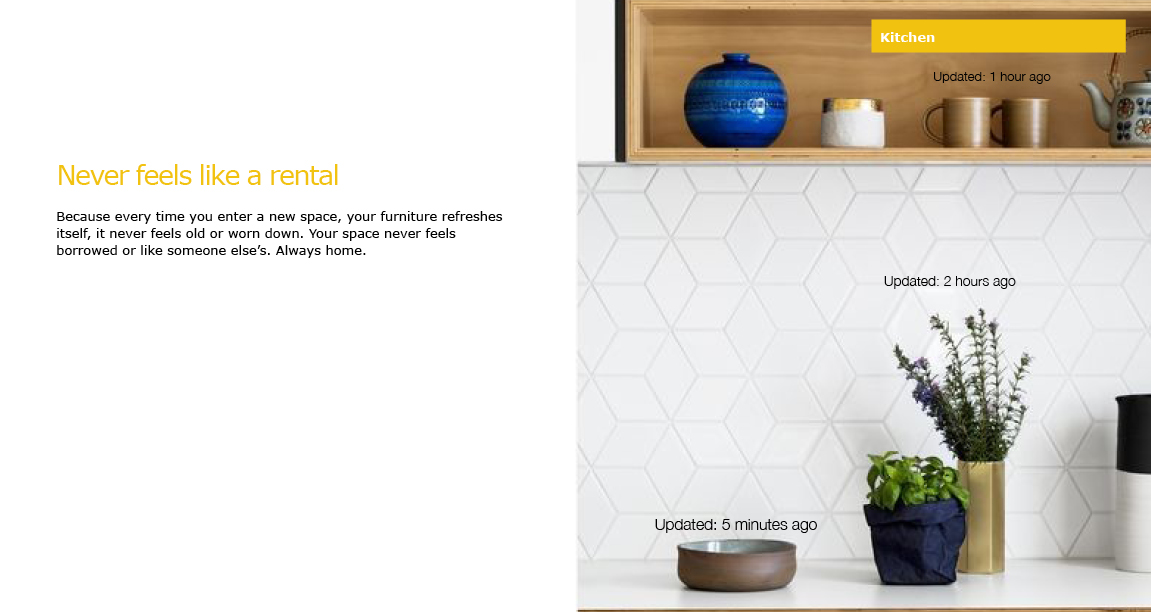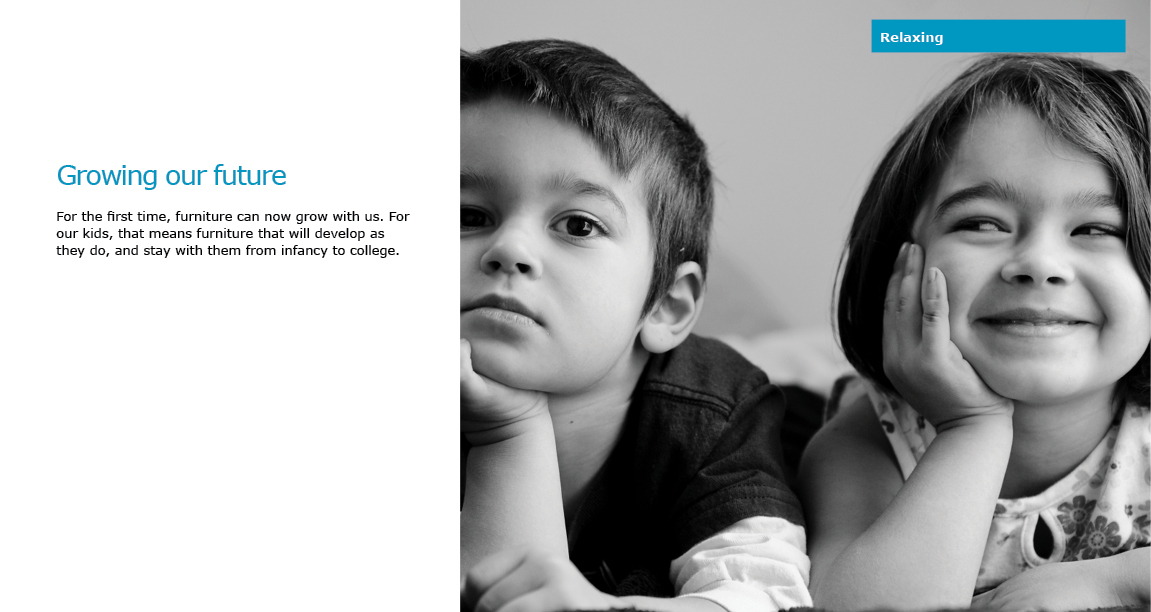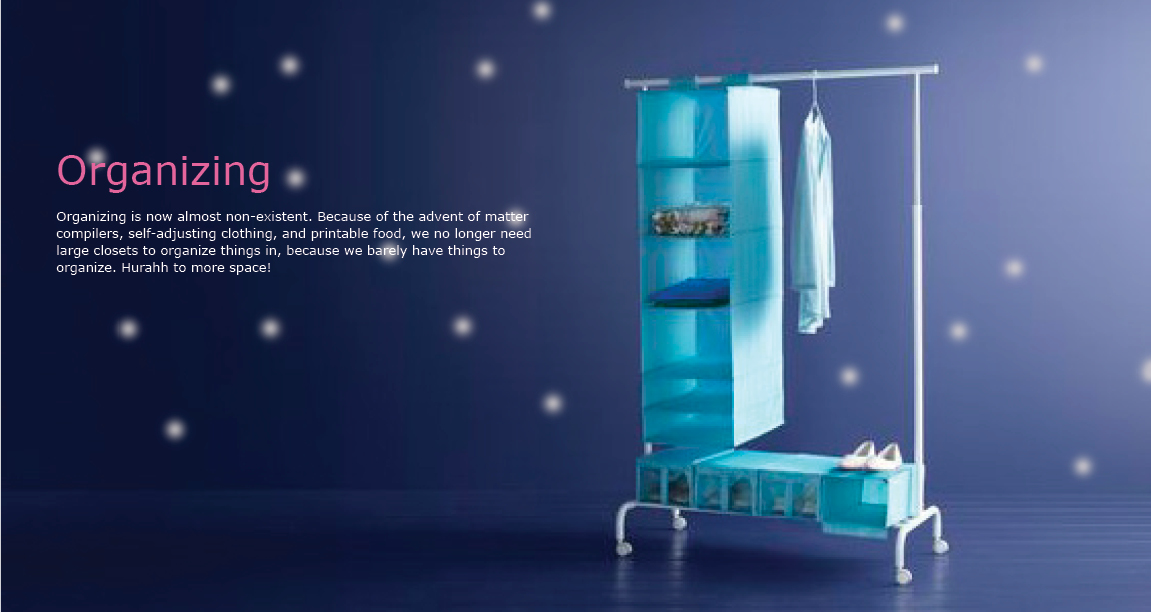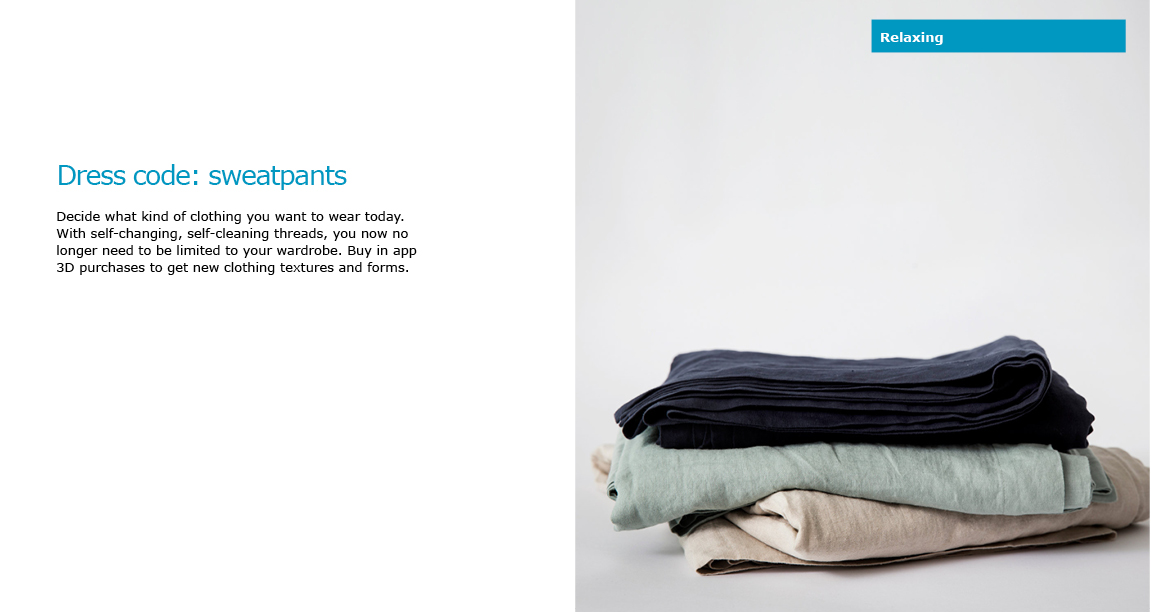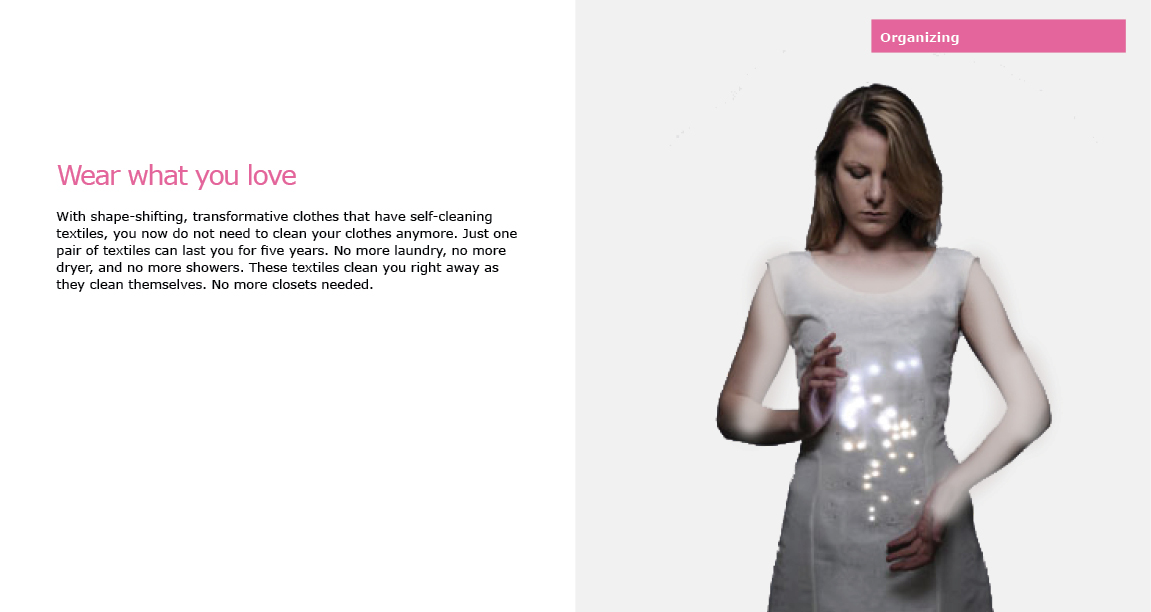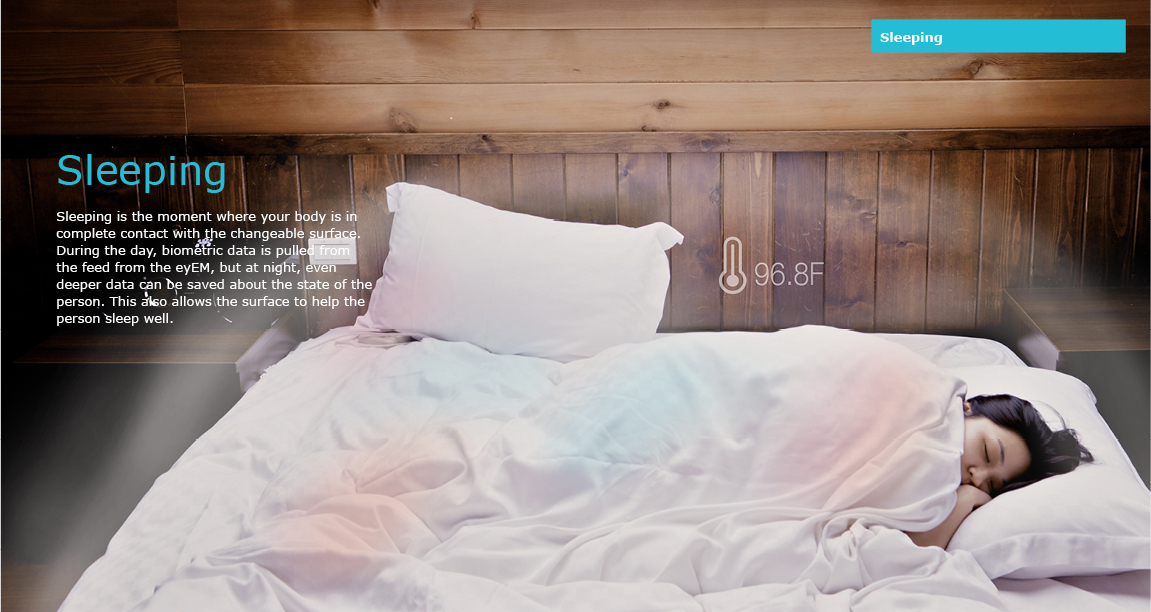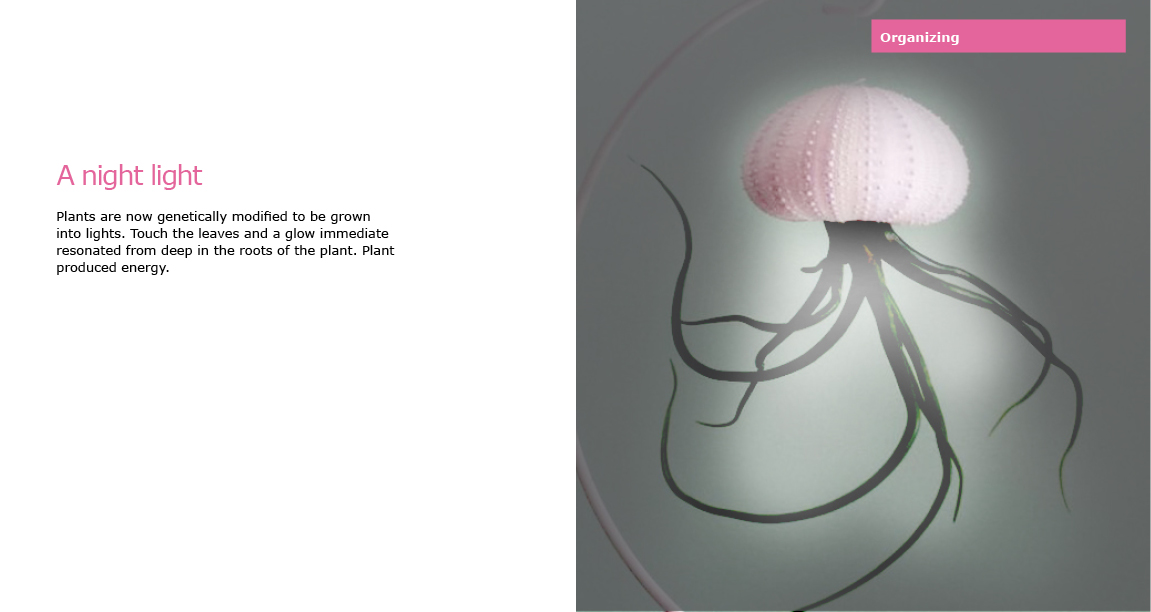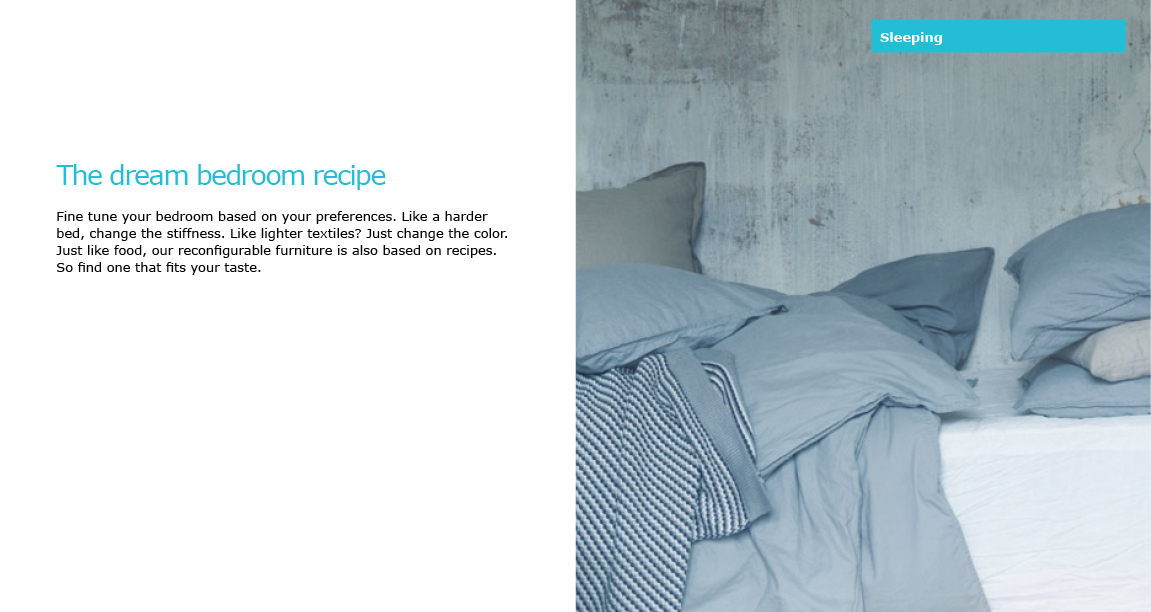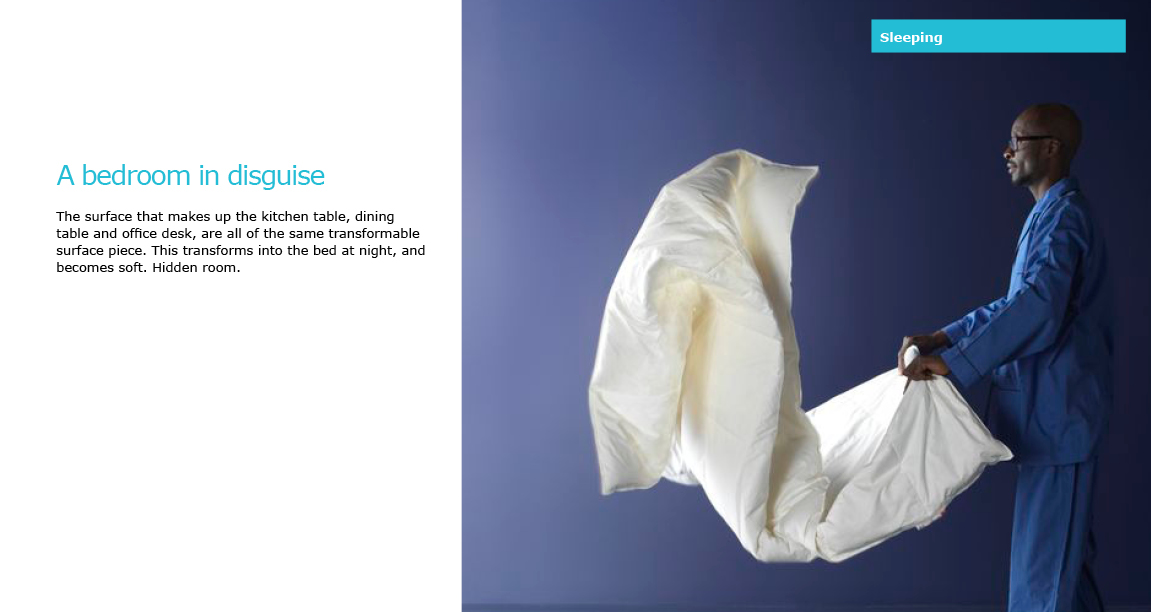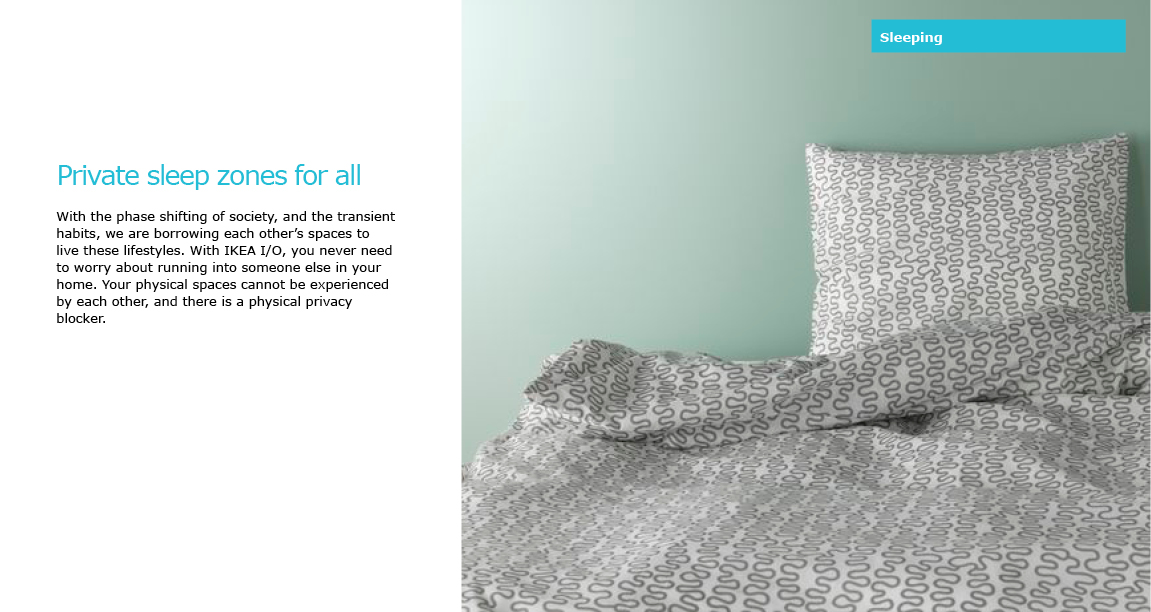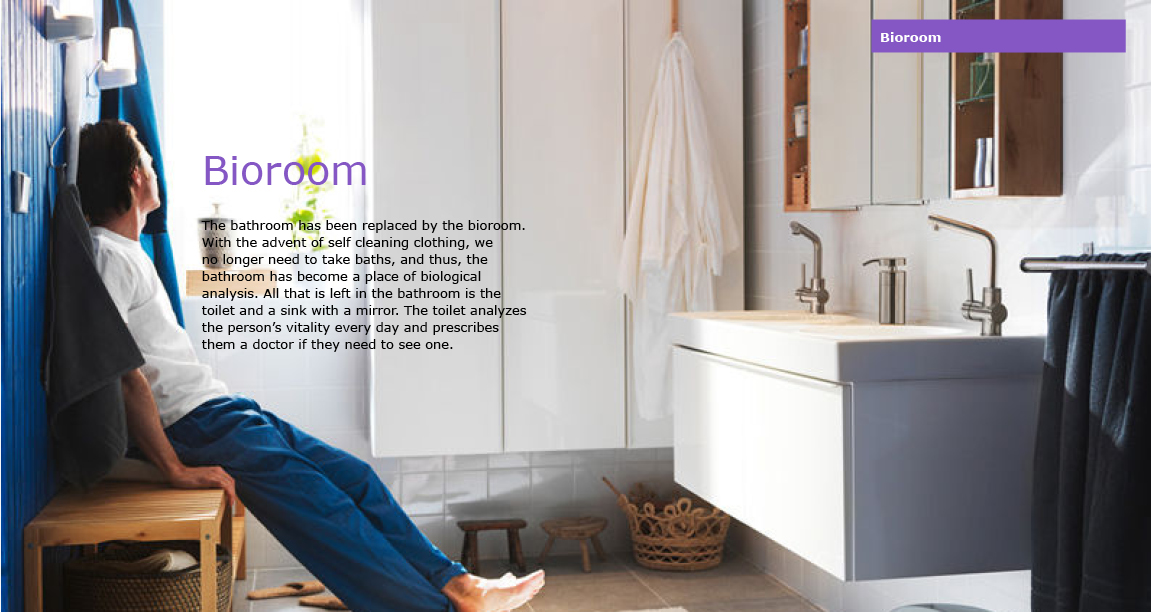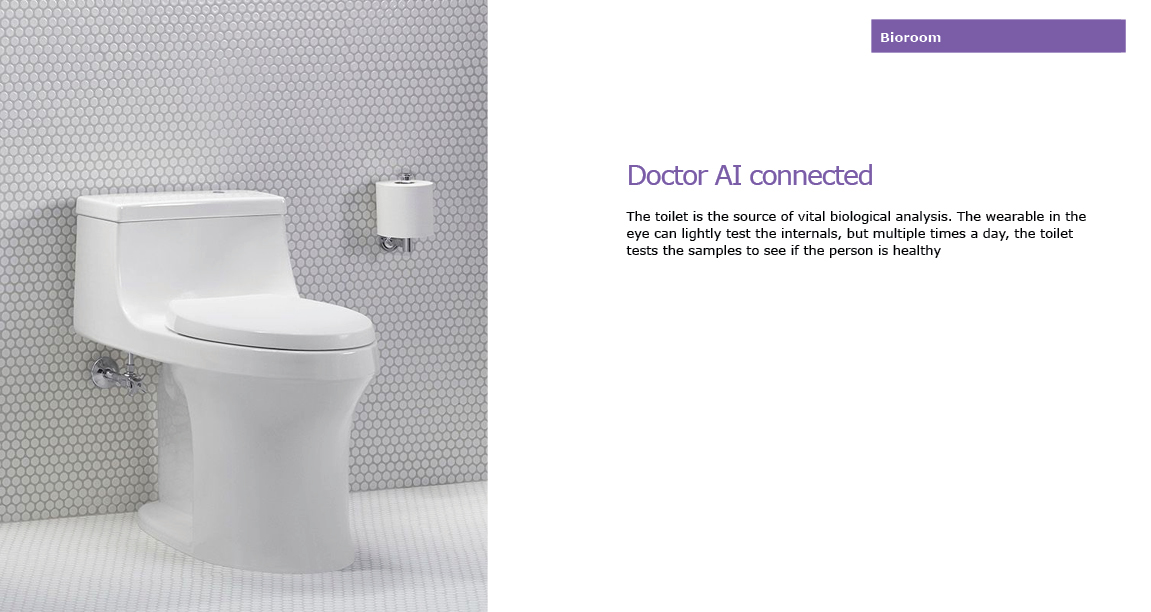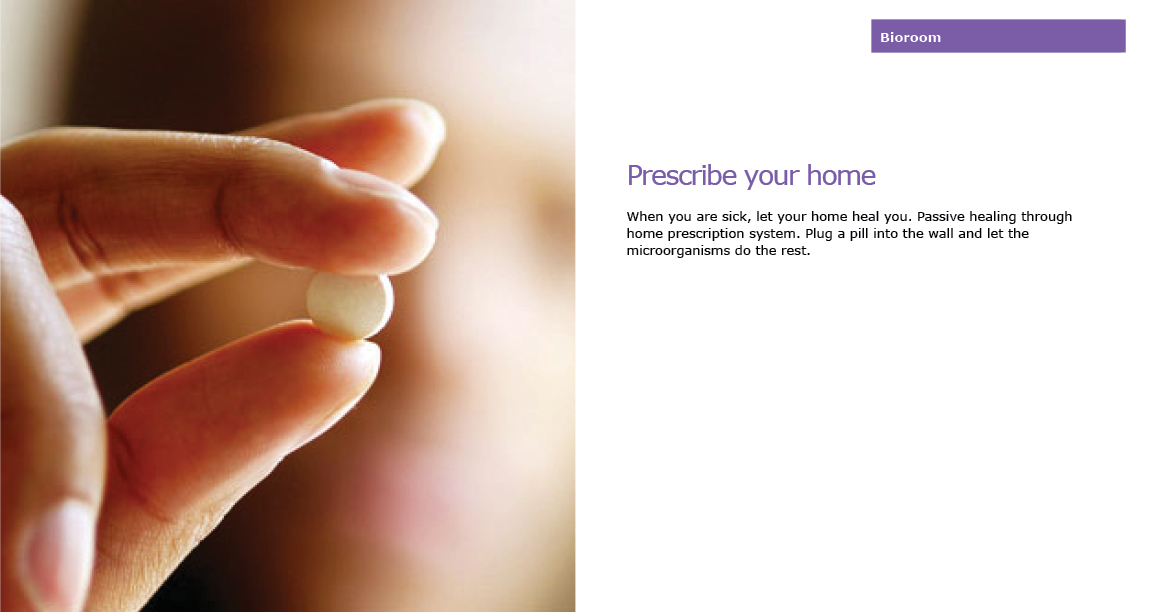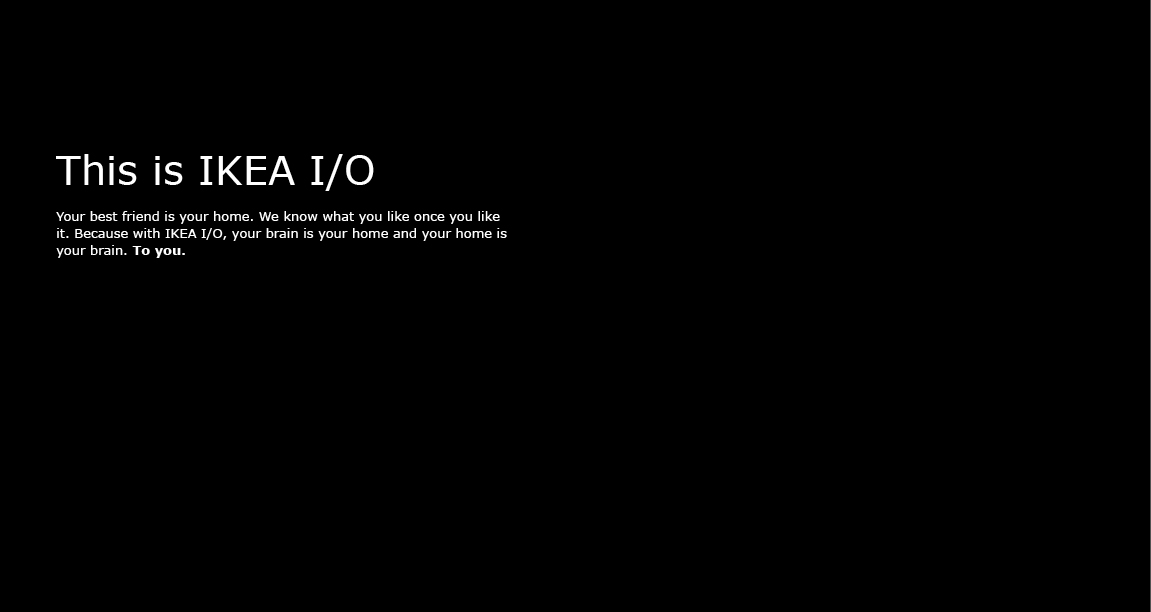Ikea I/o: the home of 2050
design research, interface design, innovation
IKEA I/O is a design fiction that crafts a global vision of architectural space and the home in the year 2050, through the format of the yearly IKEA catalog. The project questions every aspect of the home, from the kitchen, to surface materials, to new room typologies, and new interfaces.
MIT Media Lab "Science Fiction Fabrication" - Professors: Joe Paradiso, Joost Bonsen and Dan Novy
IKEA I/O: 2050
2050 Futures
Future 2050
Universal Identity: There are no more borders between countries in the world. Fluctuating between place to place has become the norm. The advent of a world government, along with a standard currency, required the standardization of identity systems. Identities were segmented and messy at the initial introduction of the networked world. The same people had different identities for each interface, and wavered on their daily lives between informal and formal identity systems. The advent of a world government and currency, along with the acceleration of the Internet of Things, led to the eventual adoption of a trackable Universal Identity System. This new identity system is hyperlinked, and every time it is verified, the event is logged. This allows for the relationships between things, and behaviors of people to be much more intertwined, and feed data to the smart objects around us.
Neural Tribe: Since the world is now post-geographic, people still need commonalities to be able to share and connect with. With the constant stream of consciousness that is flowing through the Identity cloud, citizens can now easily be grouped together through their commonalities, and create tribes to be citizens of.
Future of Home:
HomEI: This is the brain of the entire 2050 home operating system. It is the central nervous system of the operation of the home. HomEI is the newest evolution of AI, into EI (extended intelligence). The user live streams their data from their eyEI system so that the home can think like them, and understand their preferences, read their biometrics wirelessly, and identify them when they need to be verified. In 2050, there is enough data in the world about human behavior that the house does not need to learn about the human, but just be trained.
Post-Geographic Space: Because of the exponential increase in population that has occurred by 2050, cities have become denser, and thus, spaces have shrunk in size. The home has decreased drastically in physical size, but because of the ubiquity of programmable matter, spaces can swiftly and accurately reconfigure based on the user’s needs. HomEI absorbs the data from the daily life of the user’s profile from eyEI. Because the home now knows the user as if it had their brain, it can anticipate the routine/actions that the user will take, and plan its reconfiguration around them. It redesigns the space through voxel manipulation, and can easily turn a bedroom into a kitchen. Since materials in this post-geographic space are tunable, what was once a table, could turn into a bed seamlessly.
Transient Living: In 2050, the combination of hyperspeed travel, teleportation, and borderless world government means that people are much more transient. They are not confined to a single home, or residence. Because of this, people are always traveling from space to space, and thus, need some spatial stability in order to feel comfortable. Since address is now specific to the username of the person, a new kind of home system was implemented. The user can now take their home with them in their pocket, and travel to a new “home” and have the space configure itself with all of their spatial preferences. All they need to do is be authenticated by their eyEI system, and their presets are automatically applied. To the space they are inhabiting at that moment.
Time Zone Subscription: With the exponential growth of Transient Living, and the elimination of borders, people start committing to more biological means of home. They start subscribing to time-zones instead of specific homes to rent in. They pay their rent to those time zones and are allowed to stay there as a result. Phase Shifting: Not only are people traveling more, but they are also altering the norm of what it means to be awake and asleep during night and day. Because of the ability to augment their visual and auditory environments, it is biologically possible to have no effect from a change in phase. This means that multiple people can now live in a space during the same day, but can alternate living there without any disruption or interference.
Future of Material
Programmable Matter: In 2050, we will go from programmed pixels, to having the ability to re-configure and program matter. This will allow the furniture and walls in our homes to be able to be customizable, grow with us, adopt to our changes, and update as new models are available, as easily as our software interfaces get updated today.
Biological Blockchain: This is where all of the recipes for synthetic biological combinations exist. The programmable bio-walls receive a live feed of this cloud, and can update whenever viruses spread, or new wetware is introduced.
BVAC (Bio-ventilation air-conditioning: The walls are made of bio-matter, and regulate the atmosphere within the space, like a host and a body. Architectural environmental systems are all regulated by microorganisms on the wall. Temperature, humidity, pressure, smell, are all tuned to the preferences of the inhabitants. You can insert prescriptions into the “skin” if you are sick, and have the atmosphere heal you from the outside in. You can also buy pills to insert into the walls to update a specific prescription of atmospheric conditions.
Future of Furniture:
Spatial Subscription: IKEA and other furniture retailers move away from selling single pieces of furniture, but move towards maintainers of the space. The user buys a subscription, and gets tiered access to basic furniture types, and can have in app purchases to upgrade and unlock more possibilities and features. This system now allows the inhabitant to receive the newest forms of furniture on demand, right in their home. Delivery is in the furniture itself.
Furniture I/O: The furniture layouts, typologies, and forms can all reconfigure themselves. With a subscription, the inhabitant can get new physical updates overnight. There are standard pieces of furniture that come with every home, which are part of the basics pack. But the user can extend that with in-app purchases. These pieces are “carried” from place to place as the inhabitant moved, and can just be grown-loaded by the home. Because of the matter updating nature of the pieces, the furniture can now grow and adapt to the user, and stay with them through all phases of life. They can upgrade to better forms, get new models when they get uploaded, and have their furniture change when the EI realized their daily routines changed. This also allows for incremental changes on a daily basis. If someone starts to sit in one specific spot often, Furniture I/O could start to mold itself around their form.
Mobile Home: The mobile home is the term that is used to refer to the developed spatial configurations that can be taken from space to space and implemented.
Atmospheres
Plants: Plant lights. Synthetically transformed to be luminous, and light up when touched. Plants are lamps. You grow your lights, and plant new ones when you need them.
Personal Lighting: Lights that travel on the material surface to follow human. Can be turned on or off with gestures
Photoreal Lighting: In order to adjust to the shifting routines of day and night, the home
needs to help offset the effects of phase shift living. Windows are now filtered, and can
mimic the light of the sun indoors when it is night, along with making it look like it is
night during the day.
Multi-modal material: Walls made up of matter transforming material. Can change texture, color, pattern, stiffness, opacity and density. Programmed wall type. Can also be used on furniture and other surfaces. “Painted on” screen for matter transformation.
Meal Prep Space (kitchen)
Meal Preparation
Fridge Food Printer: Fridge as holder of ingredients in wall section. Upload recipes and get them assembled, cooked and printed. No more food storage, just ingredient storage. Subscriptions to certain food companies: ex. Soylent, McDonald's, Pillsbury. They have IP on the recipes, and you buy the cartridges for the ingredients. A subscription buys you the ability to unlock those recipes. If you cancel the subscription, but still have the cartridge, the fridge cannot print that combination.
Food Cartridges: Because of environmental sensitivity, in 2050, it’s hard for food to grow and be cultivated naturally outside in nature. So people have turned to consume nutrients from synthetic food-ingredients that are dried, and unfold/form when they are processed by the Fridge Food Printer. These cartridges are bought
Fridge Delivery System: When you order “delivery” from any of the delivery companies like GrubHub, your Fridge Food Printer gets access to that recipe and prints it on demand right into your home.
Liquid Printer: The sink now has multi-modal properties very similar to the fridge. There are pre-programmed flavors and textures that mix when given a recipe of drink. For example, a subscription to Coca-Cola, would provide you with the ability to turn your sink into a soda dispenser one minute, and a coffee machine in the next.
Consumption verification: In order to be able to order a meal, the user’s nutritional balance must be approved. If the meal has too much salt for the user’s needs for example, it will suggest another recipe that is better fit for their current biometric state, and reject the command to make that meal or drink.
Container/utensil compiler: The appropriate utensils are printed with the dish as a package with the plate. After the food has been eaten, the material goes back into the matter compiler for the next time it needs to be dispensed.
Consumption:
Surface-conditioning: When the meal or drink has finished printing, its temperature stays at the level it should be at due to ubiquitous surface temperature conditioning. The smart bio-surfaces can keep the dish warm, or the drink cold through surface contact.
Organic Waste: In 2050, the only waste that exists is organic waste. Everything is compostable, and perishable, and plastics are banned to help deal with the environmental crisis. When waste is created in the home, the inhabitant can just leave it in its location, and the microorganisms on the surface, regulating the atmosphere will consume it. What is waste for the human, becomes nourishment for the home. A messy home feeds the space.
Eat-Work-Sleep-Surface (dining + office + bedroom)
EWSuface: Since there is reconfigurable matter in 2050, surfaces can now change texture, stiffness, color, etc. This means that they can take on more modes of activities than before. The EWSurface is the horizontal surface in the home that transforms between dining table, work table, and bed. It can transform its height, length and width when it needs to, and even take on a soft texture when it becomes a mattress.
Surface Conditioning: As the table does in the kitchen surface, the EWSurface can also warm the inhabitant at night when it is a bed, or cool them down when it is hot and they are working.
Storage Closet
Matter Compiler: There is no longer a need for storage for everyday things. They can be printed on command. And since clothing is no longer disposable, there is no need for clothing storage.
Self Updating Clothing: Textiles that have the ability to alter their color, silhouette, thickness, texture and patterns. These clothes are the only pair that people wear today because they can transform from work clothing, to dresses, to pajamas so they are the only set necessary. They are worn 24/7.
Self Cleaning Clothing: Laundry and Dryers used to be necessary in order to clean worn clothing. But with the advent of self-cleaning, self-healing threads, their use now is null. Since clothing can now self-clean, the need to ever take it off is unnecessary.
Bio-room (bathroom):
No Shower: Textiles clean the body, so there is no need to shower anymore other than for luxury purposes.
Doctor AI Toilet: Toilet analyzes samples and cross references them with data from Fridge Printer to determine if there are any medical anomalies that need to be addressed by a doctor.
Self-healing space: Prescribe your space medication by inserting it into the wall to passively heal you from the outside in.
Future of Body
eyEI: The 2050 relationship between space and self is a very intimate one. Cellphones went from external computers, to contact lens implantables that connected directly to the cloud for information retrieval. Humans have gone from owning their data on drives, and personal devices, to keeping it all on genetic cloud servers, retrievable instantaneously. Owning data became too difficult as file sizes became too big to manage at the level of internet of things. This allowed the personal implantable to flourish as the primary interface. The eyEI (EI standing for the evolution of Artificial Intelligence to Extended Intelligence) is a personal computing device that augments the user’s field of view, senses biometric data, gathers all external memory data (such as speech, searches, photos, etc.), and authenticates identity.
Chrono-correction: Since there are in-eye implantables, and people are constantly traveling, the body needs to adjust to the changing time zones, and odd waking hours. The eyEI system augments the light color and brightness entering the eye so the user can experience night while it’s day, or slowly adjust to a new time zone. Augmented Aural Experience: With the direct implantation of aural augmentation wetware into the ear, the user could Ubiquitous Aural Assistant: That “voice in your head” is now real. That voice assistant you love so much that whispers things into your ear is now ubiquitous and context-aware. Have a conversation with anything in your home to interface with it.


